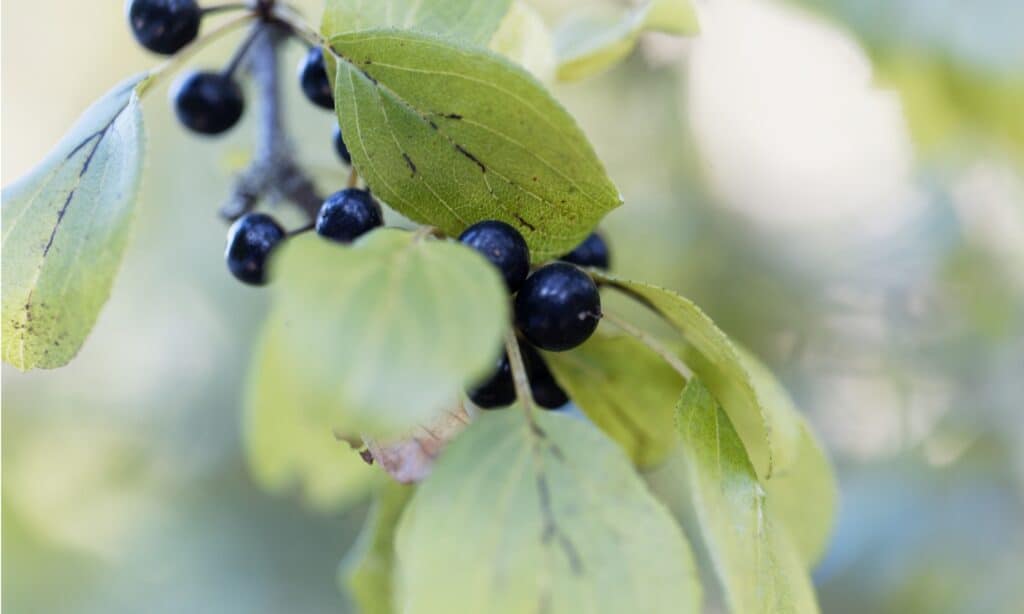Buckthorns and chokecherries are often confused with one another. While the structure and leaves on these plants look similar, there are key differences in functionality. There are also notable differences in the flowers and fruit. Buckthorns are invasive and harmful, while chokecherries are a great shrub for landscaping and harvesting. So, buckthorn vs. chokecherry: here’s how to tell the difference between the two so you know which to grow and which to remove from your property.

Buckthorn vs. Chokecherry: A Comparison
| Buckthorn | Chokecherry | |
|---|---|---|
| Classification | Rhamnus cathartica | Prunus virginiana |
| Other Names | Purging buckthorn, European buckthorn, Common buckthorn | Bitter berry, Virginia bird cherry, Bird berry |
| Origin | Europe, Asia, Africa | North America |
| Description | Small deciduous trees typically growing to 30 feet, though some grow to 50 feet. Dark green ovaline leaves grow up to six inches long and remain green year-round. Yellow-green small flowers grow in small clusters close to the stem. Berries are black and grow in clusters with several seeds inside. | Small deciduous trees typically grow to 30 feet, though some grow to 50 feet. Dark green ovaline leaves grow up to six inches long and remain green year-round. Yellow-green small flowers grow in small clusters close to the stem. Berries are black and grow in clusters with several seeds inside. |
| Uses | Traditionally used for medicinal purposes. The elements of this plant have a purgative effect and shouldn’t be consumed. | Traditionally foraged by Native Americans for food and medicinal purposes. Now a common feature in pies, pastries, and other baked goods. |
| Flavor Profile | Tart with citrus tones. These berries are inedible and harmful to animals and humans. | Astringent, bitter, and sour when raw. Tart and semi-sweet when cooked. |
| Growing Tips | Hardy plants grow in USDA zones 2-7. Thrives in loamy soil. Buckthorn is an invasive species in North America and shouldn’t be planted— experts advise immediate removal. | Hardy plants grow in USDA zones 2-10. Grow in loamy, sandy soil with continuous moisture. This invasive plant will overtake nearby plants and isn’t suitable for a garden environment. |
What Are The Key Differences Between Buckthorn and Chokecherry?
Buckthorn and chokecherries are similar in appearance and often confused with one another. The key difference is in functionality. Buckthorn is an invasive species in North America with berries and bark that cause gastrointestinal distress when consumed. Chokecherries are a great wind block and privacy plant with edible berries.
Let’s explore the overarching differences between buckthorn and chokecherry plants in detail.
Buckthorn vs. Chokecherry: Classification
Buckthorns and chokecherries are both in the order Rosales which consists of flowering plants. Despite similarities in appearance, this is where the commonality ends. Buckthorns are in the Rhamnaceae family, also known as the buckthorn family. Chokecherries are in the Rosaceae family, also known as the rose family.
Buckthorn vs. Chokecherry: Origin
Buckthorns were originally introduced to North America as an ornamental plant in the 1800s. They have since become an invasive species in North America, particularly across Canada. Chokecherries are native to North America, while buckthorns are native to Europe, Africa, and Asia.
Buckthorns are prone to harmful fungus growth and wintering soybean aphids, which harm local crops. The increasing populations of soybean aphids have attracted equally harmful multi-colored Asian lady beetles.

Buckthorns are invasive species in North America.
©iStock.com/weisschr
Buckthorn vs. Chokecherry: Description
Buckthorns and chokecherries are similar at a glance, with notable differences upon inspection. The best way to tell these plants apart is to look at the flowers and berries.
Buckthorn berries are entirely black, whereas chokecherry berries have red tones. They have several seeds inside, whereas chokecherries have a single pit.
Buckthorn flowers are subtle and clustered close to the stem. These small, four-petal flowers are a yellow-green tone. Chokecherry flowers are noticeable and vivid, with five white petals and an orange-toned center. Chokecherries are a member of the rose family, and their blooms are similar to wild roses.

Chokecherries have red tones.
©iStock.com/Elenakirey
Buckthorn vs. Chokecherry: Uses
Buckthorns are not fit for human or animal consumption. The berries and bark are poisonous to animals and have a laxative effect on humans. While buckthorn has been traditionally used in herbal medicine, it’s not recommended for modern purposes.
Chokecherries are a great hedge alternative for creating privacy and windbreaks. The berries can be harvested to make baked goods and jams.
Buckthorn vs. Chokecherry: Growth Tips
Chokecherry seeds require germination through cold stratification. Harvest the berries during the fall to extract the pits. Rinse the fruit from the pit and place it in a sealed container with a moistened paper towel. Keep the pit in the refrigerator for up to three months before transferring it to loamy soil.
Chokecherries can grow in pots or be transferred to the ground. This hardy plant doesn’t require special attention for the winter but benefits from regular fertilization.
Buckthorns should not be grown. Experts advise removing them if found on your property. Unlike other deciduous trees, buckthorn doesn’t lose its leaves during the winter, making this season ideal for removal. If you live in North America and find a buckthorn grove, contact the local agricultural office to report it.

Chokecherries should be fertilized regularly.
©iStock.com/rparys
Up Next:
- Chokecherry vs Chokeberry: Is There a Difference?
- What Do Crows Eat? 15-Plus Foods They Love!
- 5 Invasive Plants in the Mississippi River
The photo featured at the top of this post is © iStock.com/Elenakirey
Thank you for reading! Have some feedback for us? Contact the AZ Animals editorial team.






